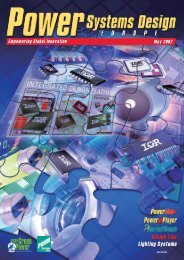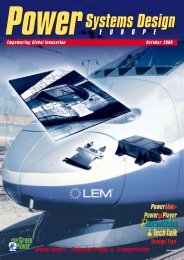Testing Virtual ECUs - Power Systems Design
Testing Virtual ECUs - Power Systems Design
Testing Virtual ECUs - Power Systems Design
You also want an ePaper? Increase the reach of your titles
YUMPU automatically turns print PDFs into web optimized ePapers that Google loves.
18<br />
Cover Story<br />
has been equipped with a thermal<br />
network model, including the air<br />
windage (e.g. cooling) effects. In<br />
order to construct the testbench<br />
with a realistic electrical consumer<br />
and supply environment that<br />
would be found in a vehicle, additional<br />
parts have been added from<br />
the standard SaberRD model library:<br />
Lithium Ion battery, cabling,<br />
and configurable power loads to<br />
model various mission profiles of<br />
the vehicle.<br />
Consumer loads are incorporated<br />
to model load dump scenarios and<br />
can be either be used directly from<br />
the model library or modeled with<br />
a load modeling tool. This feature<br />
allows users to graphically define<br />
loads and configure models with<br />
different operating characteristics<br />
(e.g. cyclic switching). From here<br />
many important system simulations<br />
can be performed to validate<br />
and optimize resonant load behavior,<br />
load dump and transient<br />
suppression protection or detailed<br />
field current regulator implementations.<br />
Important accurate fault behavior<br />
can be analyzed for conditions<br />
such as shorted or open<br />
diode connections, or field winding<br />
shorts in the alternator. The<br />
system model also accounts for<br />
dynamic charging and discharging<br />
behavior of the battery depending<br />
on the system loadings and the<br />
alternator’s ability to supply sufficient<br />
electrical power.<br />
The alternator’s supply ability is<br />
impacted by the rotational speed<br />
of the armature shaft as well as<br />
losses due to mechanical friction,<br />
damping and thermal behavior associated<br />
with the alternator components.<br />
All of these effects can<br />
be taken into account using the<br />
SaberRD simulation and modeling<br />
solution. Vehicle platform optimization<br />
can no longer afford to<br />
overly simplify or ignore the impact<br />
of electrical systems on size,<br />
mass, placement, performance<br />
and cost of the components and<br />
subsystems that define the final<br />
production vehicle.<br />
SaberRD’s links to TCAD device<br />
simulation tools provide another<br />
important opportunity for hybridelectric<br />
and full electric vehicle<br />
applications: co-optimization of<br />
the devices (IGBTs, MOSFETs,<br />
and diodes) and the application<br />
(inverters, DC/DC converters,<br />
etc.). Rather than having to rely<br />
on repackaging of existing classes<br />
of power devices and then utilizing<br />
circuit techniques to compensate<br />
for less than ideal performance<br />
of devices, it is now possible to<br />
perform virtual device iterations<br />
and generate accurate circuitlevel<br />
models in a short enough<br />
timeframe to link the efforts of<br />
the circuit designers and device<br />
designers in real time. For different<br />
applications, different device<br />
characteristics can affect overall<br />
efficiency of the circuit.<br />
Understanding the application<br />
needs and being able to create<br />
accurate circuit simulation models<br />
from detailed device physics allows<br />
power semiconductor com-<br />
panies to more quickly develop<br />
differentiated solutions specifically<br />
designed for vehicle power electronics<br />
challenges. Add to this the<br />
capability to extract thermal impedance<br />
models from detailed 2-D<br />
and 3-D geometric and material<br />
data in the TCAD environment and<br />
then quickly generate an equivalent<br />
thermal impedance network<br />
for system simulation and now<br />
there is a comprehensive tool flow<br />
addressing two of the most critical<br />
aspects of hybrid-electric and<br />
electric vehicle design long before<br />
physical prototypes are even available.<br />
Support for a Model Supply Chain<br />
Today’s complex electrical systems<br />
are composed of components and<br />
sub-systems designed, developed<br />
and manufactured by numerous<br />
different companies. In order to<br />
understand system behavior, it<br />
is important to have a common<br />
language between different tiers of<br />
the supply chain through which to<br />
communicate requirements, performance<br />
and anomalous operation<br />
characteristics of the physical<br />
content of the system.<br />
As domain experts with respect to<br />
the components and subsystems<br />
they deliver, suppliers are typically<br />
the best equipped to create simulation<br />
models that accurately reflect<br />
performance of real hardware.<br />
Further, they have the most direct<br />
access to performance measurements<br />
and test data required for<br />
model validation.<br />
The needs of a sub-system or<br />
system integrator have to be balanced<br />
against each contributing<br />
supplier’s ability to protect their intellectual<br />
property, yet still provide<br />
portable models that allow subsystem<br />
and system-level integration<br />
and test in a single simulation<br />
environment. The hybrid and<br />
electrical vehicle community has<br />
been looking to adopt methods<br />
and technology gained in other domains<br />
with similar power electronics<br />
content such as the aerospace<br />
industry.<br />
Saber® tools have been used<br />
successfully for power electronic<br />
system design, validation and<br />
Federal Aviation Administration<br />
(FAA) certification at major aircraft<br />
OEMs for over a decade. Typical<br />
aircraft power systems involve<br />
different voltages busses (115AC,<br />
230AC, 28VDC, 5VDC) driven by<br />
either fixed or variable frequency<br />
generators (400Hz fixed, 380Hz –<br />
800Hz variable) and a wide variety<br />
of loads, many of which include<br />
active power factor correction<br />
(PFC) circuitry and internal DC/<br />
DC converters. System stability is<br />
critical especially due to negative<br />
incremental resistance of DC/DC<br />
converters loads.<br />
These systems, while larger and<br />
more complex than typical automotive<br />
systems, have much in<br />
common with hybrid-electric and<br />
electric drivetrain power architectures.<br />
SaberRD models and<br />
simulation technology built up<br />
over years of usage in aerospace<br />
applications can readily be leveraged<br />
for hybrid-electric and pure<br />
electrical vehicle power systems.<br />
Saber’s multi-domain<br />
modeling capabilities and<br />
robust simulation algorithms<br />
typical of switchmode<br />
power systems<br />
coupled with the ability<br />
to protect intellectual<br />
property have put Saber<br />
technology at the center<br />
of these efforts. SaberRD<br />
supports standard encryption<br />
mechanisms for<br />
industry standard HDLs<br />
(e.g. IEEE standard for<br />
VHDL-AMS encryption)<br />
that allow for portability and protection<br />
from one level of the supply<br />
chain to the next. SaberRD’s<br />
analysis, post processing and report<br />
generation capabilities enable<br />
clear specification and validation<br />
definition as well as easy mechanisms<br />
to transfer pertinent data<br />
from the simulation environment<br />
to other useful forms for report<br />
generation and documentation.<br />
Another complexity arises when<br />
the different companies within a<br />
supply chain use different tools<br />
and/or languages (HDLs, programming<br />
languages, or other<br />
data standards such as IBIS or<br />
Touchstone) to model physical<br />
behavior of components. Figure<br />
3 illustrates the range of modeling<br />
languages and formats supported<br />
by SaberRD to support modeling<br />
of physical behavior from a variety<br />
of available sources.<br />
Multi-domain simulation of physical<br />
systems is only a part of the<br />
overall tool chain necessary for<br />
system design, validation and<br />
POWER SYSTEMS DESIGN JULY/AUGUST 2011<br />
Figure 3: Model formats in SaberRD<br />
production of power electronic<br />
systems for hybrid-electric and<br />
electric vehicles.<br />
SaberRD supports various important<br />
classes of integrations that<br />
enable extensive digital modeling<br />
and simulation of such systems,<br />
including:<br />
• Digital verification through cosimulation<br />
with popular digital<br />
logic simulators<br />
• <strong>Design</strong> and verification of<br />
embedded algorithms/software<br />
through co-simulation<br />
and model import with/from<br />
MathWorks® Simulink® and<br />
other tools<br />
• Validation of embedded<br />
control systems running on<br />
virtual <strong>ECUs</strong> through Synopsys<br />
<strong>Virtual</strong> Prototyping solutions<br />
• Verification of board-level<br />
analog electronics through<br />
integration with popular PCB<br />
design environments<br />
• Verification of electrical wiring<br />
and cabling through integrations<br />
into Saber Harness and<br />
WWW.POWERSYSTEMSDESIGN.COM WWW.POWERSYSTEMSDESIGN.COM<br />
19









